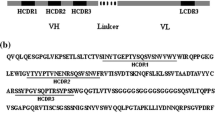Abstract
Previously, we have reported the crystal structures of Fab fragment of Infliximab in complex with TNFα. The structurally identified epitope on TNFα revealed the mechanism of TNFα inhibition by partially overlapping with the TNFα-receptor interface and the possibility to optimize the binding affinity. In this study, we launched a screen of a phage display library to isolate novel anti-TNFα antibodies based on the infliximab epitope. To develop novel anti-TNFα antibodies, structural analysis, the phage display antibody isolation, step by step antibody optimization, CDR residues random mutagenesis, and binding affinity characterization were performed. One of the novel antibodies generated on the backbone of infliximab, Inf3D6, has the superior binding affinity to TNFα, thus, demonstrating the potential for structure guided optimization for improvement of existing antibody-based therapeutics.
Similar content being viewed by others
References
Shealy D. J., Visvanathan S. 2008. Anti-TNF antibodies: lessons from the past, roadmap for the future. Handb. Exp. Pharmacol. 181, 101–129.
Pham T., Bachelez H., Berthelot J.M., Blacher J., Bouhnik Y., Claudepierre P., Constantin A., Fautrel B., Gaudin P., Goeb V., Gossec L., Goupille P., Guillaume- Czitrom S., Hachulla E., Huet I., et al. 2011. TNF alpha antagonist therapy and safety monitoring. Joint Bone Spine. 78 (Suppl. 1), 15–185.
Tansey M.G., Szymkowski D.E. 2009. The TNF superfamily in 2009: New pathways, new indications, and new drugs, Drug Discov Today. 14, 1082–1088.
Gupta A.K., Skinner A.R. 2004. A review of the use of infliximab to manage cutaneous dermatoses. J. Cutan. Med. Surg. 8, 77–89.
Liang S., Dai J., Hou S., Su L., Zhang D., Guo H., Hu S., Wang H., Rao Z., Guo Y., Lou Z. 2013. Structural basis for treating tumor necrosis factor alpha (TNFalpha)-associated diseases with the therapeutic antibody infliximab. J. Biol. Chem. 288, 13799–13807.
Hu S., Fu W., Li T., Yuan Q., Wang F., Lv G., Lv Y., Fan X., Shen Y., Lin F., Tang Y., Ye X., Yang Y., Lei C. 2017. Antagonism of EGFR and Notch limits resistance to EGFR inhibitors and radiation by decreasing tumor-initiating cell frequency. Sci. Transl. Med. 9 (380), pii: eaag0339.
Harashima S., Horiuchi T., Hatta N., Morita C., Higuchi M., Sawabe T., Tsukamoto H., Tahira T., Hayashi K., Fujita S., Niho Y. 2001. Outside-to-inside signal through the membrane TNF-α induces E-selectin (CD62E) expression on activated human CD4+ T cells. J. Immunol. 166, 130–136.
Pocsik E., Duda E., Wallach D. 1995. Phosphorylation of the 26 kDa TNF precursor in monocytic cells and in transfected HeLa cells. J. Inflamm. 45, 152–160.
Chung Y.S., Sabel K., Krönke M., Klimka A. 2008. Gene transfer of Hodgkin cell lines via multivalent anti-CD30 scFv displaying bacteriophage. BMC Mol. Biol. 9, 37.
He M., Menges M., Groves M.A., Corps E., Liu H., Brüggemann M., Taussig M.J. 1999. Selection of a human anti-progesterone antibody fragment from a transgenic mouse library by ARM ribosome display. J. Immunol. Methods. 231 (1–2), 105–117.
Coloma M.J., Hastings A., Wims L.A., Morrison S.L. 1992. Novel vectors for the expression of antibody molecules using variable regions generated by polymerase chain reaction. J. Immunol. Methods. 152 (1), 89–104.
Hayrinen J., Haseley S., Talaga P., Muhlenhoff M., Finne J., Vliegenthart J.F. 2002. High affinity binding of long-chain polysialic acid to antibody, and modulation by divalent cations and polyamines. Mol. Immunol. 39, 399–411.
Hu S., Liang S., Guo H., Zhang D., Li H., Wang X., Yang W., Qian W., Hou S., Wang H., Guo Y., Lou Z. 2013. Comparison of the inhibition mechanisms of adalimumab and infliximab in treating tumor necrosis factor α-associated diseases from a molecular view. J. Biol. Chem. 288 (38), 27059–27067.
Li B., Meng Y., Zheng L., Zhang X., Tong Q., Tan W., Hu S., Li H., Chen Y., Song J., Zhang G., Zhao L., Zhang D., Hou S., Qian W., Guo Y. 2013. Bispecific antibody to ErbB2 overcomes trastuzumab resistance through comprehensive blockade of ErbB2 heterodimerization. Cancer Res. 73 (21), 6471–6483.
Author information
Authors and Affiliations
Corresponding author
Additional information
Published in Russian in Molekulyarnaya Biologiya, 2018, Vol. 52, No. 4, pp. 628–633.
The article is published in the original.
Rights and permissions
About this article
Cite this article
Yu, XJ., Shen, YF., Dong, J. et al. Development and Optimization of Therapeutic Analogues of Anti-TNFα Antibody Infliximab. Mol Biol 52, 543–547 (2018). https://doi.org/10.1134/S0026893318040180
Received:
Accepted:
Published:
Issue Date:
DOI: https://doi.org/10.1134/S0026893318040180




